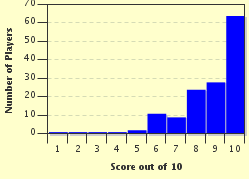Quiz Answer Key and Fun Facts
1. Based on a fairy tale written by Hans Christian Andersen in 1936, this 1.25 metre tall bronze statue sits at the waterside in Copenhagen, Denmark. What is it called?
2. Built around 600 BCE on the island of Delos, part of Greece, a row of twelve stone statues stand facing the sacred lake. They were built in honour of the Greek god Apollo. Which animal do they represent?
3. "The Motherland Calls" is an 85 metre tall sculpture in Volgograd, Russia. Built to symbolise the Battle of Stalingrad, this sculpture was inspired by an Ancient Greek sculpture. What is it called?
4. The "Spring Temple Buddha" is one of the tallest statues in the world. It stands 128 meters from the base of its lotus pedestal. The statue is made from over three thousand tonnes of copper, fifteen thousand tonnes of steel and contains over one hundred kilograms of which precious metal?
5. Auguste Rodin was the artist behind the iconic sculpture "The Thinker". Cast from bronze, this sculpture is of a large, nude male figure in pensive contemplation. "The Thinker" features in another of Rodin's works, based on Dante Alighieri's "Divine Comedy". What is it called?
6. Michelangelo completed the sculpture of the biblical figure "Moses" between 1513 - 1515. The sculpture is of a bearded Moses, seated, clutching the Ten Commandments. Due to a mistranslation in the Latin version of the Bible which Michelangelo used for reference, what is unusual about the sculpture?
7. The "Great Sphinx of Giza" is an enormous monolith carved from sandstone and has endured for millennia. It is 73 metres long and 20 metres high. Compared to the sphinx of ancient Greek mythology, what attributes would it have needed to accurately be described as a sphinx?
8. The "Statue of Liberty" was dedicated in 1886, a gift from France to the United States. The 46 metre copper statue, a representation of the Roman goddess Libertas, was designed by French sculptor Frédéric Auguste Bartholdi and built by which well known French architect?
9. "Christ the Redeemer" is a 30 metre tall statue situated on the Corcovado mountain in Rio de Janeiro, Brazil. Its internal structure is made of concrete, but its outer covering is made of what kind of stone?
10. The Rapa Nui people carved a set of human figures called "Moai". More than nine hundred of these sculptures have been found on this island in the Pacific ocean. What is it called?
Source: Author
kino76
This quiz was reviewed by FunTrivia editor
ponycargirl before going online.
Any errors found in FunTrivia content are routinely corrected through our feedback system.
